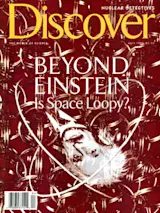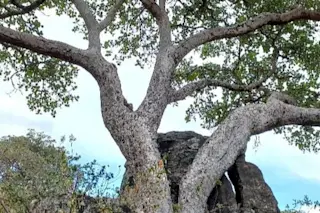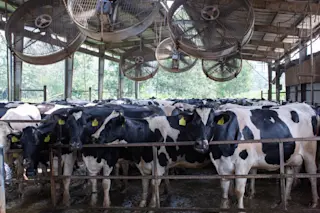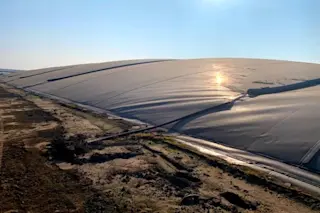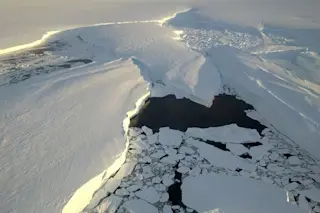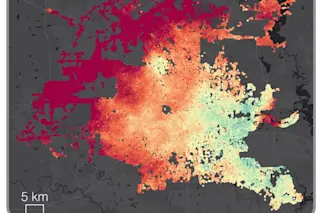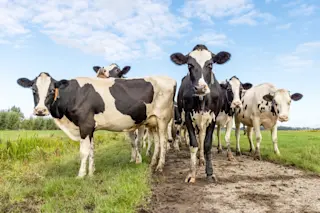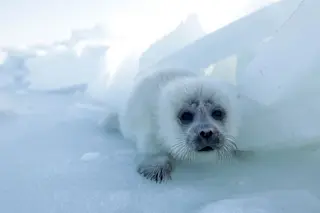Maotian Mountain just doesn’t seem to fit in with its surroundings these days. Set in the high country of southwest China, overlooking the town of Chengjiang, this little peak stands framed against a postcard-perfect lake and terraced tobacco fields that lead up to the tropical sky like some giant staircase. Here in the central Yunnan plateau, spring weather lasts all year long and the air carries a crisp fragrance mercifully free of the pollution that chokes cities to the east.
The small mountain itself, however, is looking a little haggard. Maotian today displays a face pockmarked by gaping pits, heaps of broken stone, and bald patches stripped of vegetation. In the last few years scientists have blasted Maotian with dynamite and hired local peasants to whack at it with shovels; even foreign dignitaries have taken a few cracks at the clay-colored rock. It seems that everyone has an urge to disfigure this unassuming ridge.
The assault on Maotian started in 1984, when Chinese paleontologist Hou Xianguang split open a stone on the west face of the mountain and discovered an unfamiliar egg-size fossil. Although the animal had spent more than a half-billion years entombed in rock, it had weathered the eons so well that Hou could discern its individual limbs, spread out like an army marching in single file; in Hou’s trembling hands this long- dead creature seemed caught in the act of scuttling across the rain-soaked stone. Thus began one of the most important fossil discoveries of the century.
Prospecting around the town of Chengjiang, Hou and other researchers have since uncovered thousands of exquisitely preserved fossils that offer a glimpse back to a pivotal event in the history of life. This moment, right at the start of Earth’s Cambrian Period, some 550 million years ago, marks the evolutionary explosion that filled the seas with the world’s first complex creatures. In a blink of geologic time a planet dominated by simple spongelike animals gave way to one ruled by a vast variety of sophisticated beasts, animals whose relatives still inhabit the world today. This biological big bang reverberated through all facets of existence, altering not only the shape of animals but also the way they lived together. It was at this time that the world’s first predators appeared, an event that forever split life into the hunters and the hunted.
Today, after nine years spent analyzing these fossils, Hou and his colleagues are faced with a startling conclusion. The picture emerging from Chengjiang reveals that the animal kingdom took shape far faster than researchers had previously thought. Life rocketed from primeval to modern in the space of a few million years, an astonishingly short period of time. For paleontologists, the Chengjiang fossils fire the imagination because they offer a chance to understand how this happened. This is Genesis material, gushed one researcher, in reviewing a paper written by Hou and his colleagues.
When ordinarily sober-minded scientists reach for biblical references, it’s clear that something unusual has turned up--a fact Hou quickly recognized that fateful day on Maotian Mountain. When I found the first fossil, I didn’t know what this animal was. I didn’t know its detailed structure. But I realized that you could see the impression of the soft body parts. That night I put the fossils under my bed. But because I was so excited, I couldn’t sleep very well. I got up often and pulled out the fossils just to look at them.
Soft-tissue impressions like these represent the rarest of all fossil finds. Most animals, when they die, decompose without leaving any trace. If conditions do conspire to form a fossil, it’s almost always the case that only the mineral-rich parts of the body, such as teeth, bones, or solid shells, are preserved. As a rule, softer, unmineralized features like muscles, skin, and insect exoskeleton fall apart far too quickly to survive the eons. Infrequently, though, that rule breaks down and fossil hunters will find the remnants of whole animals staring them in the face.
In one of the great ironies of paleontology, another of these extremely rare soft-tissue finds turned up the day after Hou made the Chengjiang discovery: nearly halfway around the world, in northern Greenland, a team of researchers uncovered a set of soft-body fossils at a Cambrian-age site. Prior to these finds, the last major discovery of such well-preserved Cambrian fossils occurred 75 years earlier in the Burgess Shale of western Canada. Because of their unique status, these three Cambrian sites have earned the appellation Lagerstätte. This German word translates literally as lode place, as in the English mining expression mother lode.
Of the three Cambrian Lagerstätten, the Burgess Shale has the most venerable history. Since its discovery in 1909, this site has shaped the way researchers view the origin of modern animals. But fossils from the Canadian site can’t provide a clear picture of the actual evolutionary explosion because they hail from the middle of the period, some 15 to 20 million years after the start of the Cambrian drama. Trying to interpret the earliest events by studying the Burgess Shale is like walking into Macbeth in the middle of the third act--although the principal characters are still alive at that point, it would be difficult to piece together exactly how the tragic Scotsman got himself into such a pickle.
Both Chengjiang and the Greenland site lie much closer to the Cambrian’s start, so they raise the curtain nearer to the beginning of the play. The Chinese site is believed to fall within about 5 million years of the Cambrian boundary, and the Greenland site appears to be somewhat later. Even so close to the start, though, the fossils from Chengjiang show a remarkable diversity in the broad body types, or phyla, that had evolved by then. There are some fleshy, clamlike creatures anchored inside shells, others with exoskeletons, jointed legs, and complete digestive systems, and still others at just about every point in between.
The Chengjiang fauna demonstrates that the large animal phyla of today were present already in the early Cambrian and that they were as distinct from each other then as they are today, says Jan Bergström, a paleontologist at the Swedish Museum of Natural History in Stockholm. Bergström was the first foreign paleontologist to visit Chengjiang after Hou’s discovery, and the two have worked side by side in Sweden since Hou arrived there three years ago. The time available for evolving this early Cambrian fauna is very much shorter now, Bergström says. We have just 5 million years instead of the 20 million years that we had when only the Burgess Shale fauna was known.
When Bergström discusses the Cambrian events, he’s really talking about an innovation in biological architecture. Before the start of the Cambrian, the most complex creatures visible in the fossil record had bodies about as interesting as an Oreo cookie without the filling. Like sponges and jellyfish, these Precambrian animals had exteriors and interiors but lacked a middle layer of tissue--the mesoderm, which forms skeleton, muscle tissue, the circulatory system, and some internal organs. They had no hearts; they had no brains.
Without a mesoderm, these early creatures--called the Ediacara fauna--could do little more than spend quiet lives anchored to the seafloor or floating in the ocean currents. Some of the Ediacara forms look so different from modern life that several paleontologists believe they weren’t even animals. Instead they may represent a separate offshoot of multicellular evolution that left no heirs in the modern world.
Judging from fossilized tracks in the Precambrian rock, researchers surmise that the Ediacara fauna had some company in the seas. Apparently wormlike creatures had evolved by this time and were slithering across the seafloor. But the traces they left are none too complicated, suggesting these first crawlers had relatively simple forms.
Take a short step forward in time to the Cambrian, though, and you step into a marvelous world of animal innovation. Exoskeletons and hard shells appear for the first time, as do such biological novelties as legs, antennae, and segmented bodies. Shuffle these features together in various arrangements and you get the broad categories of modern ocean life. Not only did the Cambrian beasts look wholly unlike their predecessors, they also had developed an entirely different style of life. For the first time in the planet’s history, animals were highly mobile, displaying a newfound ability to swim, walk, and even burrow complex, tunnellike mazes through the seafloor sediments. Within the rocks of Chengjiang, paleontologists have found a menagerie of clam cousins, sponges, segmented worms, and other invertebrates that would seem vaguely familiar to any scuba diver.
Animals called Branchiocaris, for instance, appear to have been remarkably like shrimp, while plump Vetulicola could have been early forerunners of lobsters, with their long segmented tails at one end and beady little eyes at the other. The community also included representatives of some lesser-known phyla that have only a few surviving members today. Lingulella was a bivalve creature called a brachiopod, whose descendants still resemble a clam on the outside but have a quite different structure inside. Another surviving group, the priapulids, burrow in the sand and feed by sticking their extendable proboscises up into the water--an act that makes it clear why zoologists gave this phylum a name that translates as little penis.
By 1991, Bergström, Hou, and their colleagues had pieced together enough information about the Chengjiang fossils to publish a prehistoric census report on that community’s remarkable diversity. In terms of sheer numbers, arthropods--animals with no backbone but with jointed limbs and a segmented body--dominated the scene, with more species fitting into this phylum than any other. That same pattern still holds true today: Arthropoda, the phylum that includes the insects, holds 86 percent of all know living animal species.
Of all the animals, though, a group of small, unassuming creatures called lobopods may turn out to be the unexpected stars of the Chengjiang fauna. Members of this group had long bodies and walked on rows of balloonish legs--an arrangement that spurred one fanciful paleontologist to call them a cross between a centipede and the Michelin man. Today lobopods are a rare phylum relegated to living under decaying leaves in tropical forests. But in the early Cambrian these animals evolved a variety of forms far more diverse than their modern incarnations. Many of the Cambrian lobopods had an armored appearance, with hard plates and spikes on their backs.
The militant look was not just for fashion. Small animals like the lobopods would have needed defensive weapons against some of the other creatures turning up in the Chengjiang fossils, says Chen Junyuan, a researcher at the Nanjing Institute of Geology and Paleontology. One of the spectacular things we have found is monsters, the earliest monsters, Chen says excitedly, pausing to let the impact of the words sink in.
Chen’s monsters are actually large, toothy animals that represent the earliest known predators in the fossil record. In a sense, the appearance of these creatures marks the birth of violence, when one set of large bullies began snacking on weaker animals. So started the evolutionary arms race between predator and prey that continues to this day.
One of the Chengjiang predators may have reached gigantic proportions relative to most of the Cambrian creatures, which generally measured no longer than a finger. Anomalocaris, an armor-plated behemoth equipped with a round mouth surrounded by knifelike blades, may have been more than three feet in length. It had spiny arms and probably moved along the ocean bottom. Similar creatures found in the Burgess Shale had remnants of other animals in their intestines, indicating that Anomalocaris was a deadly carnivore. Paleontologists have found another, even bigger mouth, which may have been part of another predator called Peytoia. The mouth consists of a circular set of plates that looks remarkably like a pineapple slice with a central hole. Inside, it has seven or eight rows of teeth that are largest near the opening and smallest toward the back of the mouth. Evidently the entire system worked like an assembly line, first chopping the prey into large bits and then passing the food farther into the mouth, where it was cut into smaller morsels.
Chen’s monsters help flesh out some of the details of the evolutionary burst at the start of the Cambrian. It not only gave birth to a pageant of different phyla, it also created animals that filled a wide variety of ecological niches, from the rock-scraping grazers, to the filter feeders, right up to the large predators. Our study shows that the ecosystem is already very advanced by the time of the Chengjiang animals, says Chen.
With its diversity of characters, the Chengjiang community raises a fundamental question that has long plagued researchers who study the Cambrian explosion: Why was the beginning of this period so different from the rest of time? Almost all the major phyla appeared in one brief burst a half-billion years ago, and nothing as dramatic has happened since then.
Sure, many new kinds of animals have developed in the intervening time, especially when organisms crawled up onto the continents for the first time and evolved bodies suited to the hazards of life out of water. Our own four-limbed chassis, for example, sports a host of features not seen on the creatures swimming through the Cambrian ocean. Yet Homo sapiens and other modern additions to the animal world do not represent wholesale changes in body plans; rather, they are mere variations on the broad themes established at the start of the Cambrian. Look back to the Burgess Shale, and you can find one animal, named Pikaia, with evidence of a hardened structure running down its back--a feature that would develop into a full- fledged backbone in later animals. Say hello to an ancient relative, for Pikaia is the earliest known member of our own phylum, the chordates.
In trying to explain the unique flowering of phyla in the Cambrian, paleontologists such as Bergström instinctively reach for the conventional answer, which centers on the key Darwinian concept of competition. In this view, animals of the Cambrian explosion had the freedom to develop new body plans because they ventured into virgin ecological territory. As the first complex animals, these creatures faced little competition from the simpler organisms already populating Earth. The Cambrian newcomers could explore a wide array of different architectural paths to exploit the planet’s bounteous resources.
But once those ecological niches were filled, the wild party ceased. No more could evolution simply slap different features together and create a viable body plan, because new additions had to compete with already successful animals occupying the available niches. In ecology, as in Congress, incumbents enjoy a strong advantage over challengers, so the odds greatly favor the established animals, making it nearly impossible for new phyla to develop.
Yet that Darwinian argument may not provide the entire answer. As interest in the Cambrian explosion has grown in recent years, many scientists outside paleontology have started exploring the problem by looking inside animals for other ways to explain the unique radiation of phyla. In particular, some researchers wonder whether creatures that appeared in the Cambrian had lost the ability to create new body plans; perhaps their genes had become wired together in too complex a fashion to allow the evolution of totally novel phyla. According to this internalistic view, once you fix all the features of development, they get very rigidly tied together and you can’t change it, says Rudolf Raff, a developmental and evolutionary biologist at Indiana University.
Think of this through the analogy of evolving a machine, explains Raff. If you have the parts, you can build a primitive bicycle, with two wheels and pedals, and then you put gears on it. You can put a motor on it and make it a motorcycle, and you can use titanium instead of steel and make it lighter. At each one of these stages you improve the thing, still staying with the basic body plan. And it becomes harder to convert it to something else, because it belongs to a different lineage than some other kind of machine. If you want to improve it, you can make any kind of change you want, but you will still have something like a bicycle, which is different from a four-wheeled vehicle like a car. You would never add a hook and ladder and make a bicycle into a fire truck. By this reasoning, once the panoply of different phyla appeared, they could not change course to form completely different body types. Evolution couldn’t alter a few features on a crab and create a sea urchin, for example.
Raff has actually tried to gauge the flexibility of developmental pathways in modern animals, focusing on two species of sea urchin that split from a common ancestor about 10 million years ago. While the species look similar in their adult forms, they go through startlingly different larval stages--a major developmental change that happened since the two species branched away from each other. One thing that tells us is that you can make really substantial changes in development in a very short period of geologic time. It doesn’t take a hundred million years to invent a new way of developing an organism, says Raff.
But in the end, this developmental divergence didn’t amount to much, because the two urchin species retain similar adult forms, suggesting that modern animals do not have unlimited freedom to alter their development. You can build an urchin another way, but you still build an urchin, says Raff. Back at the beginning of the Cambrian, however, such restrictions may not have existed, he says.
Earth itself may also have played a starring role in the Cambrian drama. Bergström thinks the ocean went through a radical chemical shift at this time that sparked the biological frenzy. It must have been something in the environment that triggered this event, he says with confidence. When asked to elaborate, Bergström spins a story about oxygen levels rising right before the Cambrian boundary. Although today’s atmosphere holds 21 percent free oxygen, there was little free oxygen in the air and oceans early in life’s history. It began accumulating in the oceans about 3.8 billion years ago, as shown by the red bands of oxidized, or rusted, iron in seafloor rocks from that time until about 2 billion years ago. As the oceans rusted out, oxygen was now free to accumulate in the environment, reaching levels high enough to support small and simple life-forms. By the time of the Ediacara animals in the late Precambrian, oxygen levels had increased enough to permit the development of large-bodied organisms. But even the Ediacara creatures may have faced oxygen limitations, for these animals were mostly flat sheets, a shape well suited for allowing even scant amounts of gas to reach the innermost cells.
Eventually, for whatever reason, enough oxygen did accumulate in the environment, says Bergström, and the increase would have triggered evolution on a grand scale. Animals could have developed complex shapes, chased after prey, built exoskeletons and shells; they could have produced everything that appeared in the Cambrian explosion.
While this makes for a good story, even Bergström admits that it may be complete fiction. Geologists really do not know when oxygen reached the levels required by complex organisms; it may have occurred long before the Cambrian’s start. Still, Bergström believes that something unusual was going on in the Cambrian environment.
Raff wonders whether a biological factor allowed animals to form modern phyla all of a sudden. For instance, some creatures may have developed the ability to scrape algae off rocks, thereby exploiting a whole new food source that would have allowed them to grow larger and more active. If that idea doesn’t appeal, Raff can rattle off a dozen others that have been suggested over the years by various scientists. Perhaps the appearance of the earliest predators forced the evolution of complex body plans with built-in defenses. Or maybe an extinction of the Precambrian creatures sparked the evolutionary explosion. It may have been that any number of causes could ultimately have done it. It’s just that one or the other did, and we don’t know which one that was, he says.
Working backward through history and connecting effects with obscure causes is easy when you have detailed records. The discovery of the Chengjiang fossils, for instance, can be traced to the unlikely cause of World War II, when thousands of Chinese academics fled the invading Japanese army and set up shop near Chengjiang. One geologist wrote a paper about some arthropod shells found on Maotian Mountain. Four decades later a paleontologist came across that paper, and it prompted him to visit the mountain. His name was Hou Xianguang, and instead of arthropod shells he found the mother lode.
But when it comes to reconstructing prehistory in the Cambrian, the problem is that scientists see the effect, but they have many causes to choose from--and not a lot of clues about the correct choice to make. You are looking at a unique event, Raff says, so you don’t have the ability to replicate it and look at another example. It’s like the joke about the first exam in astronomy, where question one goes: Define universe, and give two examples. We face the same problem. We don’t have another example of the Cambrian radiation or anything like it. We have no way of replicating it in the lab. It’s removed a half-billion years from us. So it’s a tough thing to understand.
And that is precisely why Chengjiang is so attractive to scientists grappling with these issues. The Cambrian problem is currently getting attention from diverse groups of researchers, not just the enclave devoted to studying extinct beasts. It reaches beyond paleontology. It’s not just a curiosity, says Raff. These animals are not going to end up on exhibit simply as weird-looking things. They really influence the way a lot of people think about the history of life.
As he speaks, the work crews in Chengjiang are out in force, building a better road up to Maotian Mountain to replace the old dirt path. Near the top of the ridge, sunlight glints off a marble monument covered with engraved script. Chinese characters run across one side while the other offers an introduction to the site in English. It appears that local officials are preparing for another wave of academics. This time, though, the newcomers are not driven by war; this time they follow the echoes of ancestors long past.


